Automobile manufacturing is a big industry in the United States, with a 2023 market size of over $104 billion[1] in revenue. Today, American manufacturers produce around 10 million units annually[2], which is a big drop from the historic highs of 13-15 million units in the 1970s and early 2000s.
The story of the globalization of the American auto industry to international manufacturing plants has been well-documented over the years, but just how drastic is it?
In this exclusive report, we break down all the data on the percentage of cars sold in the USA that are actually made here.
In a Nutshell
- American made cars are declining – Ford, GM, and Chrysler moved from an average of 73% US/Canadian content in their cars in 2007 to 40% in recent years.
- Honda cars sold in the US are more American by content than GM, Ford, and Chrysler.
- Mexico and Canada are popular outsourcing destinations for final assembly.
- Engine sourcing from US suppliers is on a steep decline since 2011. Chevy, Dodge, and GMC have held relatively strong, though.
- Honda and Acura brand cars have a higher percentage of models with US-sourced engines than Chevrolet, Ford, and several other American car companies.
- Transmission sourcing from US suppliers has been trending upward slightly with manufacturers like Ford moving from 57% of models with some US-sourced transmissions in 2011 to nearly 100% in 2023.
Our Methodology
Auto manufacturers that sell cars in the US are required to submit information to the US government about the country of origin for their vehicles, as mandated by the American Automobile Labeling Act. This information includes the following:
- US and Canadian parts (“content”) in the vehicle, measured by the car’s total value. Unfortunately, the numbers for the US and Canada aren’t separated.
- Countries where the final assembly took place.
- Countries of origin for the vehicle’s motor/engine.
- Countries of origin for the vehicle’s transmission.
The NHTSA (National Highway Traffic Safety Administration) publishes annual reports containing all this information dating back to 2007, which you can find here.
We downloaded every annual report, cleaned all the messy data structure that we’ve come to know and hate…umm…love from the US government, and analyzed everything.
A few data integrity notes:
- Not every manufacturer submitted data in each annual report, so there are a few gaps. We know, it’s frustrating. And we’re not sure why it’s not there. Likely apathy on the part of auto manufacturers, but we’re investigating to find out why.
- These publicly available reports only started including the countries for final assembly, engine/motor, and transmission in 2011. That data is not present for 2007 to 2010.
- The percentage of the car’s total value from the US and Canada is aggregated at the model level (example: Ford F-150) in these NHTSA reports. Therefore, much of our analysis is based on averages, which isn’t as granular as we would like, but it’s what we’re working with. If you have a specific car you’re looking to purchase, you can use the NHTSA VIN Decoder to find the country of origin.
- Final assembly location percentages are averages across all models that have at least some final assembly in a given country. The NHTSA reports do not give percentages of cars assembled in each location when multiple countries are listed.
- Engine/motor and transmission origin percentages are averages across all models with at least some engines/motors and transmissions originating from a given country. The NHTSA reports do not give percentages of car engines/motors or transmissions sourced in each location when multiple countries are listed.
Our findings, analysis, and aggregation of the data are below.
American Made Cars Are On The Decline
In 2007, cars sold in the US contained 38% US and Canadian parts on average. That portion has declined to 18% in 2023.
This trend isn’t all too surprising, as more international automakers make their way to the US, and domestic companies seek cheaper costs overseas.

Big Three Automakers Aren’t So American Anymore
This same trend continues if we zoom in on the Big Three automakers: Ford, GM, and Chrysler. GM hasn’t submitted data for the last two years, but all three manufacturers mirror each other’s production – moving from a collective 73% US/Canadian content in 2007 to 40% in recent years.
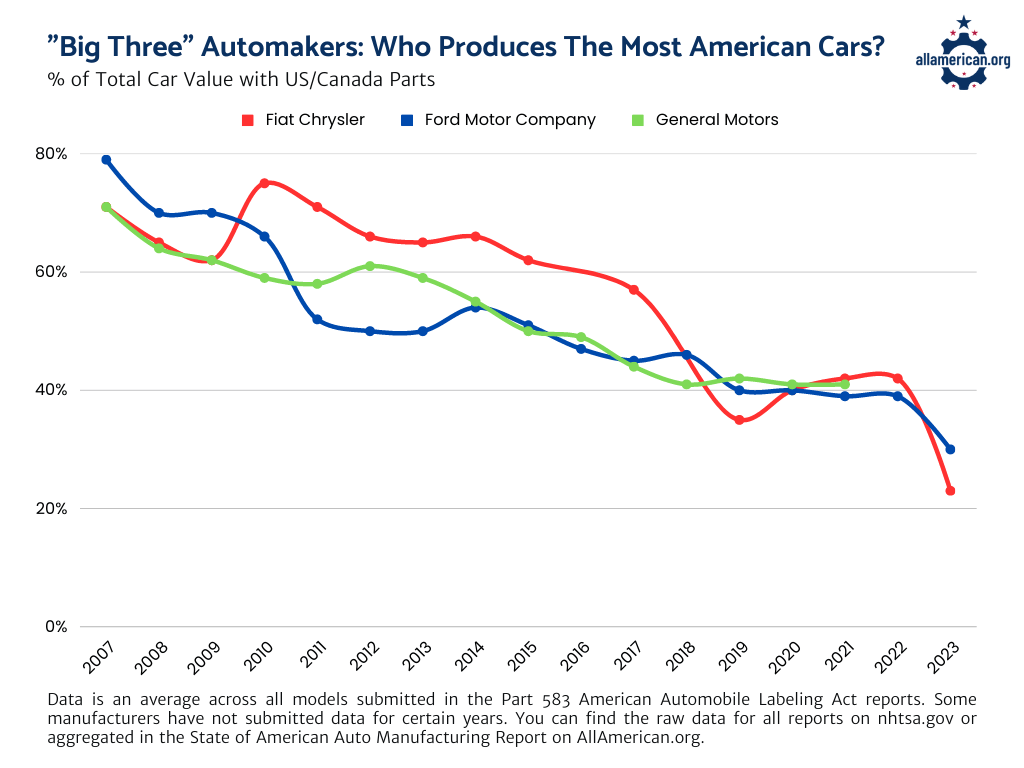
Which Manufacturers Produces The Most American Made Cars?
We looked at the data across all auto manufacturers who submitted reports and found an equally bleak story – Honda is ahead of the Big Three automakers for the average US/Canadian content across all models sold in the US (60%). Tesla ranks 1st at 65%. General Motors (41%) and Ford (30%) rank 3rd and 4th, respectively. Chrysler (23%) is behind Volkswagen (27%), Subaru (24%), and Nissan (24%).
Here’s a snapshot of those trends over the years. You can view our full dataset at the bottom of this report.
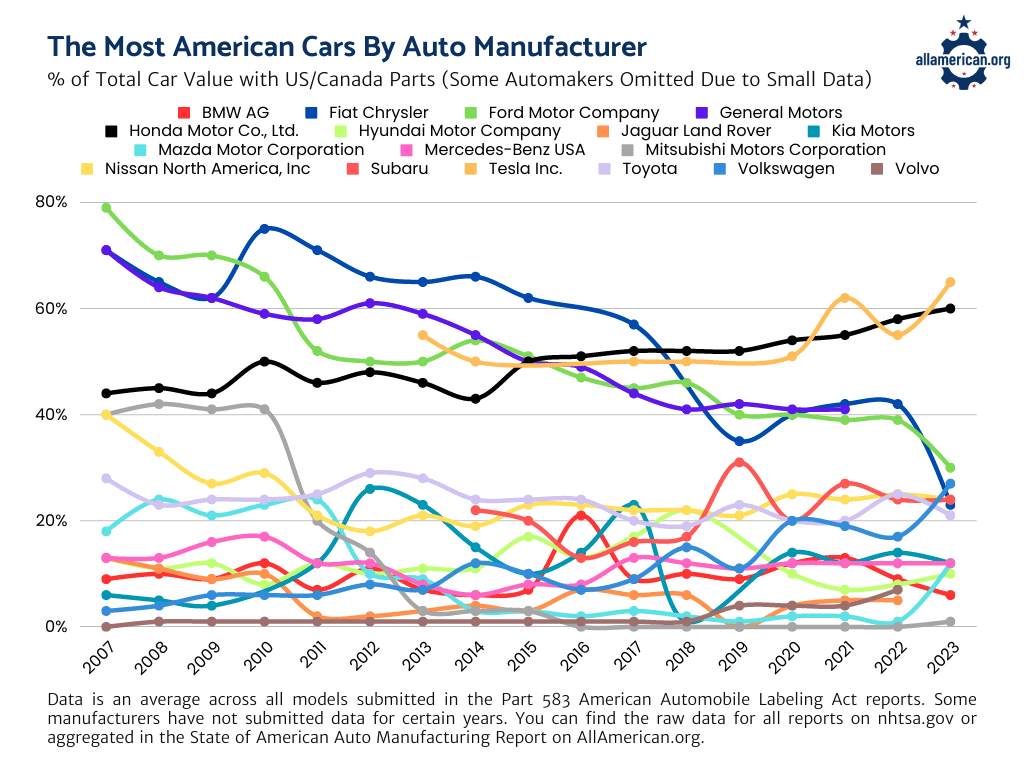
It Doesn’t Look Much Better By Make
Splitting this same data by make across all major manufacturers, we see a similar story, but with some interesting callouts.
Tesla is once again in 1st place (65%), followed by Acura (64%), Jeep (63%), and Honda (59%).
When Fiat Chrysler (now part of Stellantis) submits data for these reports, their other two most popular makes also score well. Chrysler brand cars at 69%, according to 2022 data, and Dodge at 70%. Their other specialty brands bring down their overall average.
Chrysler averages US/Canadian content in their models much better than Ford, which averages 33% for Ford brand vehicles and 25% for Lincoln.
GMC and Cadillac are the most American makes for General Motors, both averaging 48% US/Canadian content in their vehicles.
These averages are a far cry from their numbers just 15 years ago when Fords were 80% US/Canadian content, and Chevrolet was 71% (Chevy is down to 39% now).
Dodge has stayed relatively steady over the past 15 years, hovering around 60-70% US/Canadian content.
The data for popular international makes like Kia (12%), Nissan (27%), and Toyota (26%) isn’t too surprising, although it’s nice to see that they use some domestic parts.

Are American-Born Automakers At Least Doing Final Assembly in the US?
A lot of final assembly is happening in The United States for the Big Three automakers.
Jeep and Dodge (both owned by Fiat Chrysler) hovered close to 100% in recent years for models with at least some final assembly in the US.
Unfortunately, Ford is lagging – they hover around 50-60% most years. Their Lincoln brand is better, surging from 29% in 2011 to 83% in the most recent 2023 report.
General Motors is outpacing Ford, too – their GMC and Cadillac brands are consistently over 80% in recent years. The Chevrolet brand lags at 58%, which has stayed pretty steady since 2011, when this data was first reported.

Mexico and Canada Are Popular Final Assembly Locations For American Automakers
American car manufacturers assemble their vehicles in a variety of countries.
Outside of the US, General Motors mostly assembles in:
- Mexico – Accounts for some final assembly for 19% of models
- Korea – Accounts for some final assembly for 13% of models
Only one General Motors model is made in China (according to the latest data they submitted) – the Buick Envision.
Notable other final assembly countries for Ford Motor Company:
- Mexico – Accounts for some final assembly for 13% of models
- Canada – Accounts for some final assembly for 13% of models
Fiat Chrysler:
- Italy – Accounts for some final assembly for 46% of models
- Canada – Accounts for some final assembly for 17% of models
- Mexico – Accounts for some final assembly for 17% of models
Italy isn’t surprising since Fiat (an Italian company) and Chrysler merged in 2014. Fiat Chrysler is now a part of Stellantis, a new corporation formed after merging with the French PSA Group in 2021.
Across all manufacturers, Germany (20%), Japan (17%), Korea (12%), and Mexico (7%) are the most popular non-US final assembly countries, according to the most recent 2023 data.
Some Final Assembly in the US Is Common For International Auto Manufacturers
Many international automakers are beating American-born companies in terms of the percentage of their models with at least some final assembly in the US. Most notably:
- Acura (a Honda brand) is ahead of everyone – 100% of their models sold in the US have at least some US final assembly for the past three years.
- Nissan (50%) and Toyota (46%) have more models with US final assembly than Buick (33%), and in some years, Chrysler (fluctuates between 33% and 50%).
Other popular manufacturers like Hyundai (23%) and Volkswagen (46%) have some final assembly in the US, providing valuable American jobs in locations across the country.
And finally, some brands sold in the US are largely doing final assembly overseas, like Lexus (a Toyota brand) at 5% of models with some assembly in the US and Kia at 17%.

US-Sourced Engines Are Fading Among Big Three
Engine sourcing in the US is experiencing a steep decline for a few makes within the Big Three auto manufacturers. Most notably:
- Buick – 80% of models in 2011 sourced some engines from the US. That fell to 0% in 2021.
- Chrysler – 100% in 2011 to 0% in 2022
- Ford – 54% in 2011 to 33% in 2023
- Jeep – 100% in 2011 to 67% in 2023
Some American car brands have held relatively strong, though, like Chevrolet (67%), Dodge (100%), and GMC (100%).
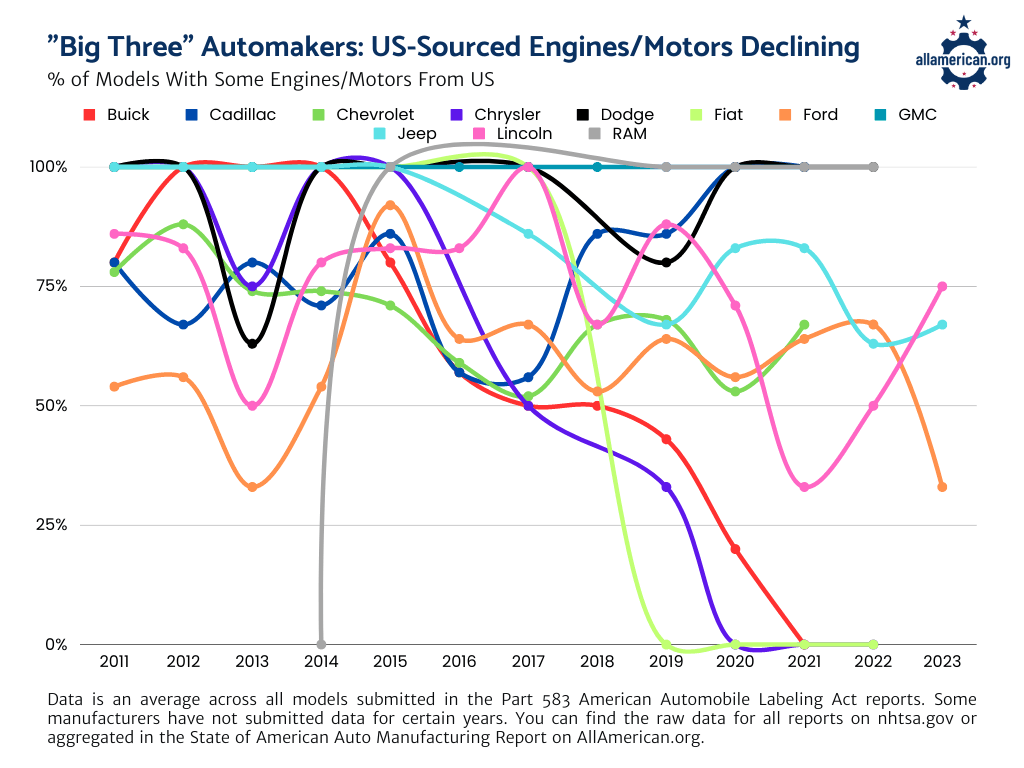
Where Are They Getting Engines From Now?
Engines and motors are sourced from a variety of countries for car manufacturers.
Here are the countries that General Motors sources the most engines from outside the US:
- Mexico – Source of engines for 16% of models
- Austria – Source of engines for 13% of models
Same as the final assembly, the Buick Envision is the only model from GM that sources its engine from China.
Now let’s break down non-US engine/motor sources for Ford Motor Company:
- Mexico – Source of engines for 47% of models
- Spain – Source of engines for 26% of models
Fiat Chrysler also has similar trends for engine/motor sources and final assembly:
- Mexico – Source of engines for 54% of models
- Italy – Source of engines for 38% of models
Poland also makes an appearance as the engine source for the Fiat 500X and Jeep Renegade.
For all manufacturers, Germany (22%), Japan (22%), Hungary (14%), and Korea (13%) are the most popular non-US countries for engine and motor sourcing.
Mixed Bag of Manufacturers Are Sourcing Engines Locally
Honda is leading all foreign companies in sourcing engines and motors from the US for cars sold here. Their Acura brand has moved from 67% of models with some engines sourced from the US in 2011 to 93% in 2023. The Honda line of cars is similar, moving from 64% to 94% over the same period.
Toyota hovers right in the middle and has been very steady over the last 10-15 years – 50% of their models sold in the US have some US engines.
Other foreign manufacturers aren’t too much of a surprise. Car companies like Volvo, Volkswagen, Mercedes-Benz, and BMW are all close to zero.

American Transmission Sourcing Holding Stronger Than Engines
US-sourced transmissions are a different story than engines; the numbers look much better for some brands within major American car companies.
Ford moved from 57% of models with some US-sourced transmissions in 2011 to 100% in the most recent 2023 data.
Other makes like Chevrolet (75%), Chrysler (100%), GMC (100%), and Cadillac (100%) are consistently sourcing transmissions in the US year after year.
Buick and Dodge have trended downwards since 2011.
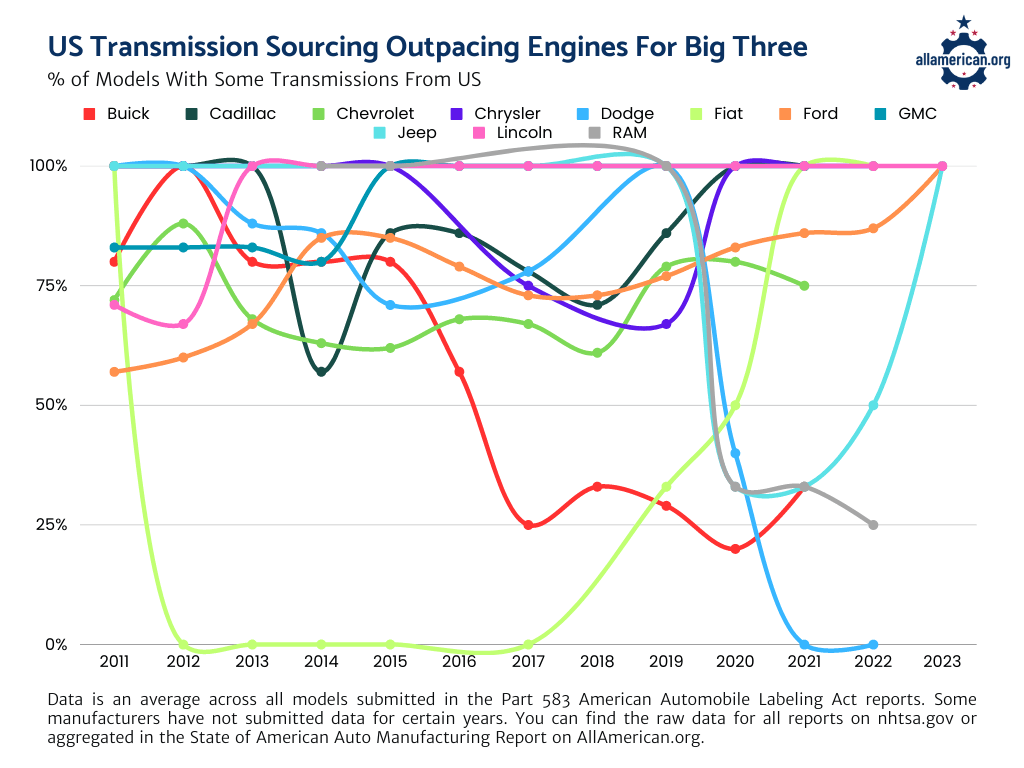
Other Common Transmission Sources For American Automakers
Transmissions are sourced from the US more often than engines/motors for the biggest American car manufacturers, but they still get them from a variety of countries.
Here is a breakdown of the biggest source countries for General Motors transmissions outside of the US:
- Mexico – Source of transmissions for 16% of models
- Korea – Source of transmissions for 13% of models
The Buick Envision is the only GM model with a transmission from China.
Let’s look at Ford Motor Company:
- Some transmissions for the Ford Bronco come from China
- The six-speed transmission for the Ford Mustang also comes from China
- The transmission for the Ford Mustang Mach-E comes from Mexico
And here’s the breakdown for Fiat Chrysler:
- Germany – Source of transmissions for 54% of models
- Japan – Source of transmissions for 13% of models
For all manufacturers, Germany (34%), Japan (27%), Korea (14%), and Hungary (7%) are the most popular non-US countries for sourcing transmissions.
Transmission Sourcing Trends For Other Auto Manufacturers
Lots of foreign manufacturers are sourcing some transmissions for their models from US suppliers. Once again, Acura (the luxury brand for Honda) and Honda make cars lead the way with 87% and 58% of models using some US-sourced transmissions. That number has grown for Acura, up from 33% in 2011.
Other big manufacturers like Kia, Hyundai, and Toyota source some transmissions from the US, but they are all under 25% of models.
Several notable manufacturers have zero models with any US-sourced transmissions: BMW, Jaguar, Mazda, Mercedes-Benz, Mitsubishi, Porsche, Subaru, and Volvo. We omitted them from the graph below, but you can see their year-by-year trends in the appendix (it’s zeroed across the board for most of these brands).
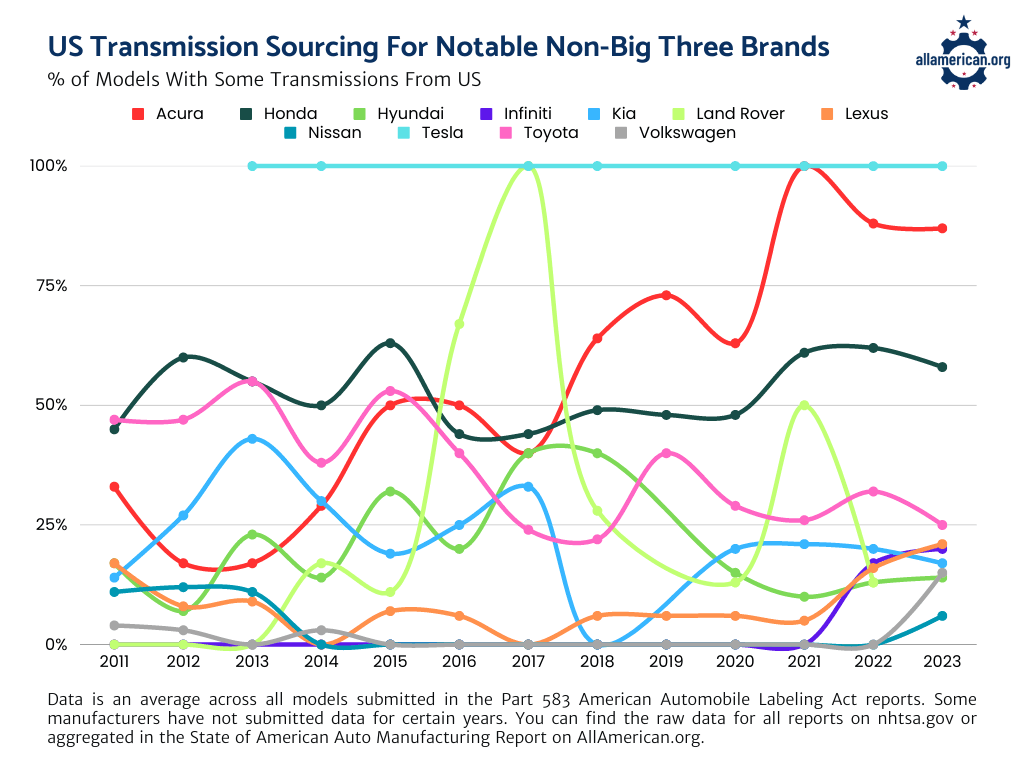
Closing Thoughts
We hope you found our State of American Auto Manufacturing Report informative. We’ll refresh this report every year as new AALA data is released.
By highlighting this data, our mission is to help improve transparency in the industry, keep auto manufacturers and our government accountable, and help everyday Americans make informed choices and support American manufacturing.
Appendix
Data is an average across all models submitted in the Part 583 American Automobile Labeling Act reports. Some manufacturers have not submitted data for certain years. See our data integrity notes at the top of the report for more information about how we compiled this data.
Percentage Of Total Car Value With Parts From The United States and Canada
By Manufacturer
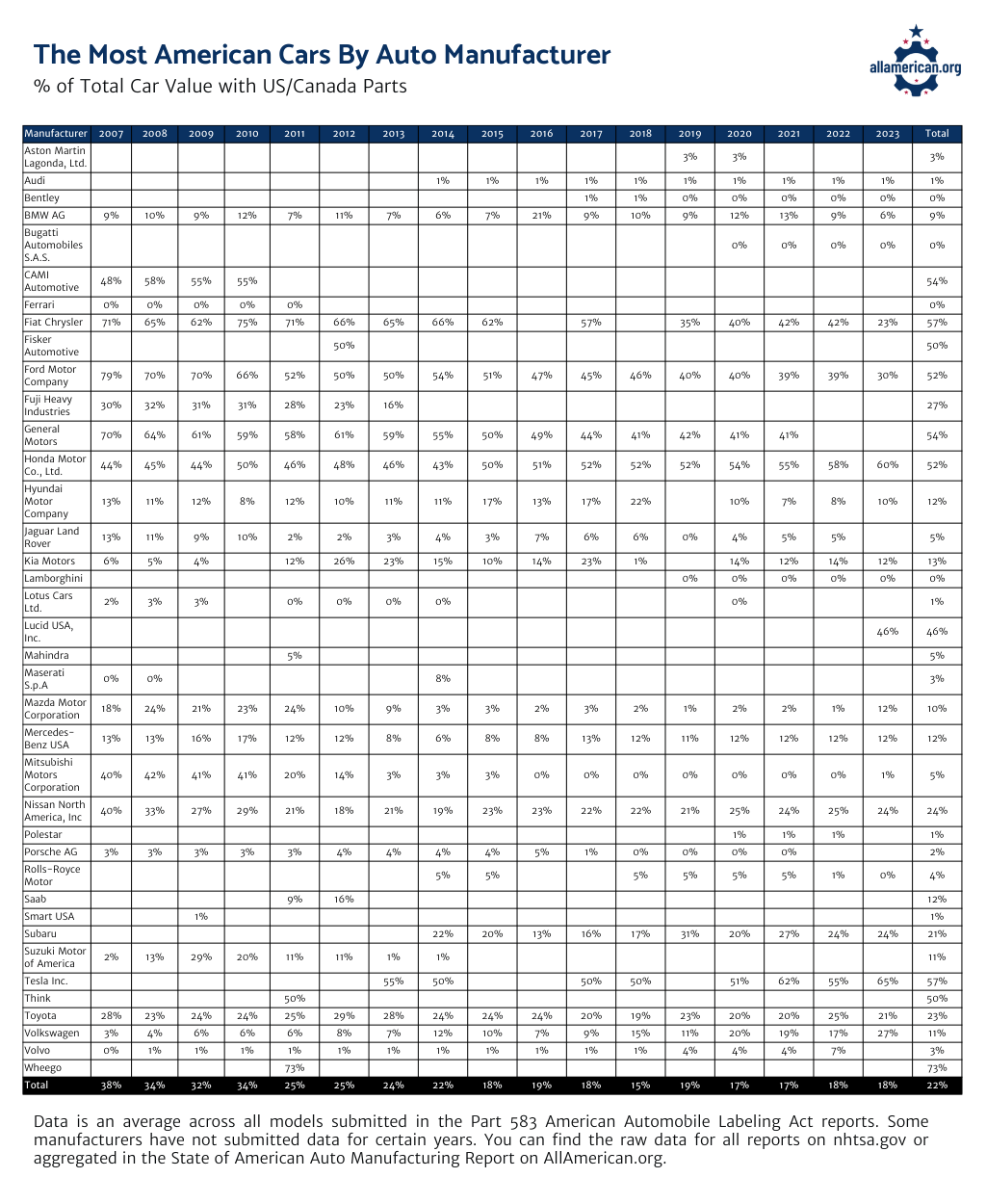
By Make
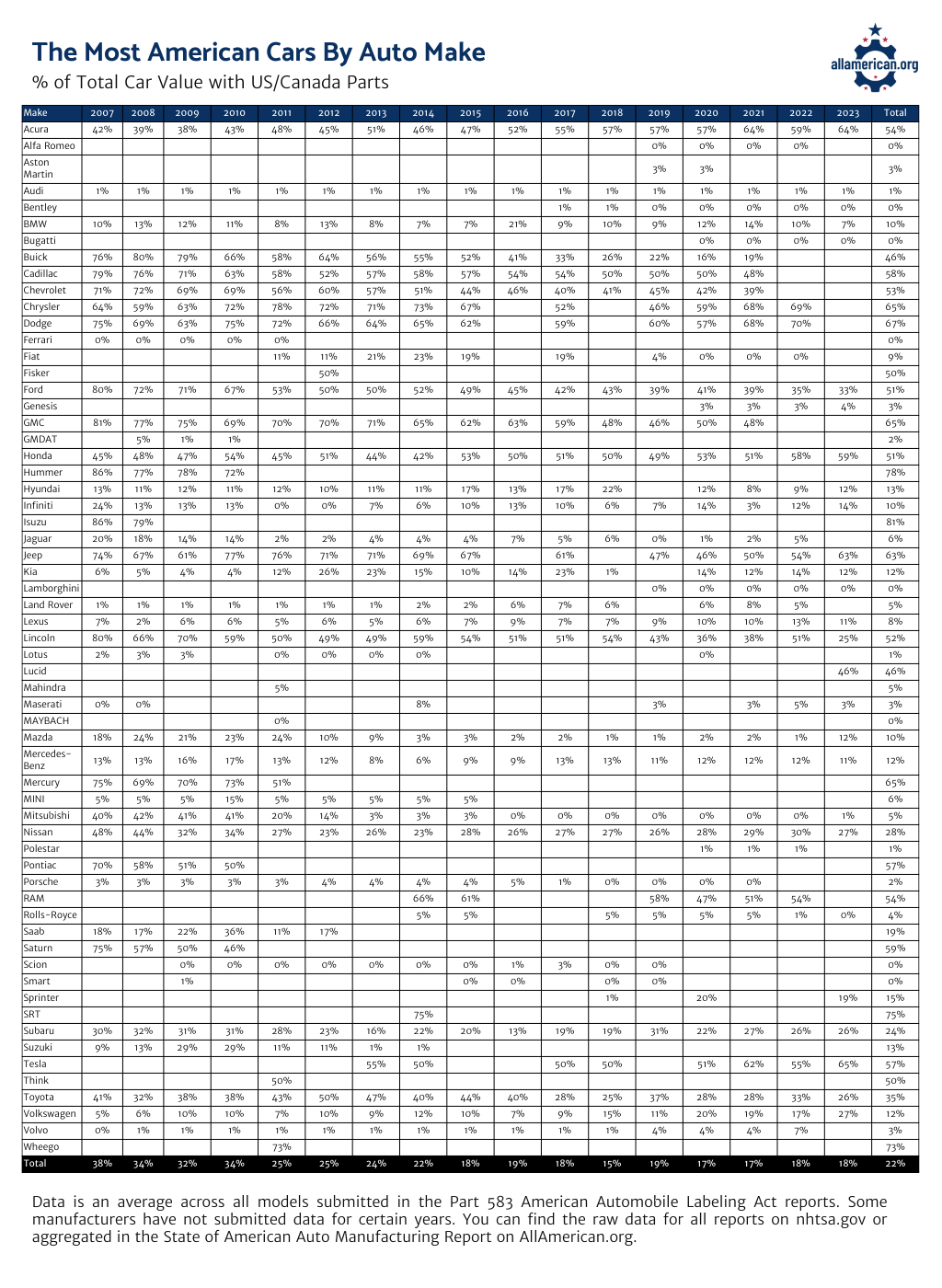
Models With Some Final Assembly In The United States
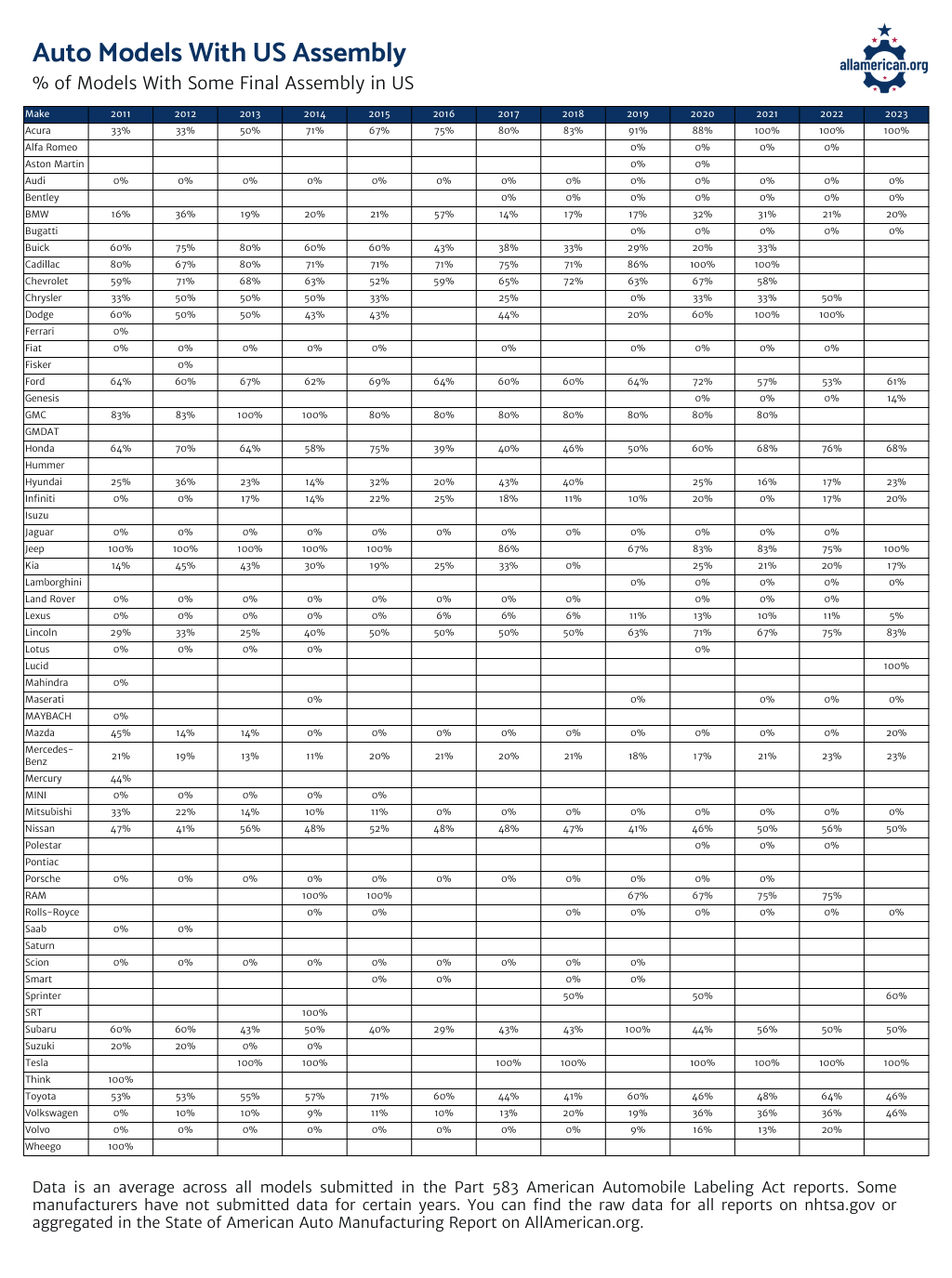
Models With Some Engines/Motors From The United States

Models With Some Transmissions From The United States
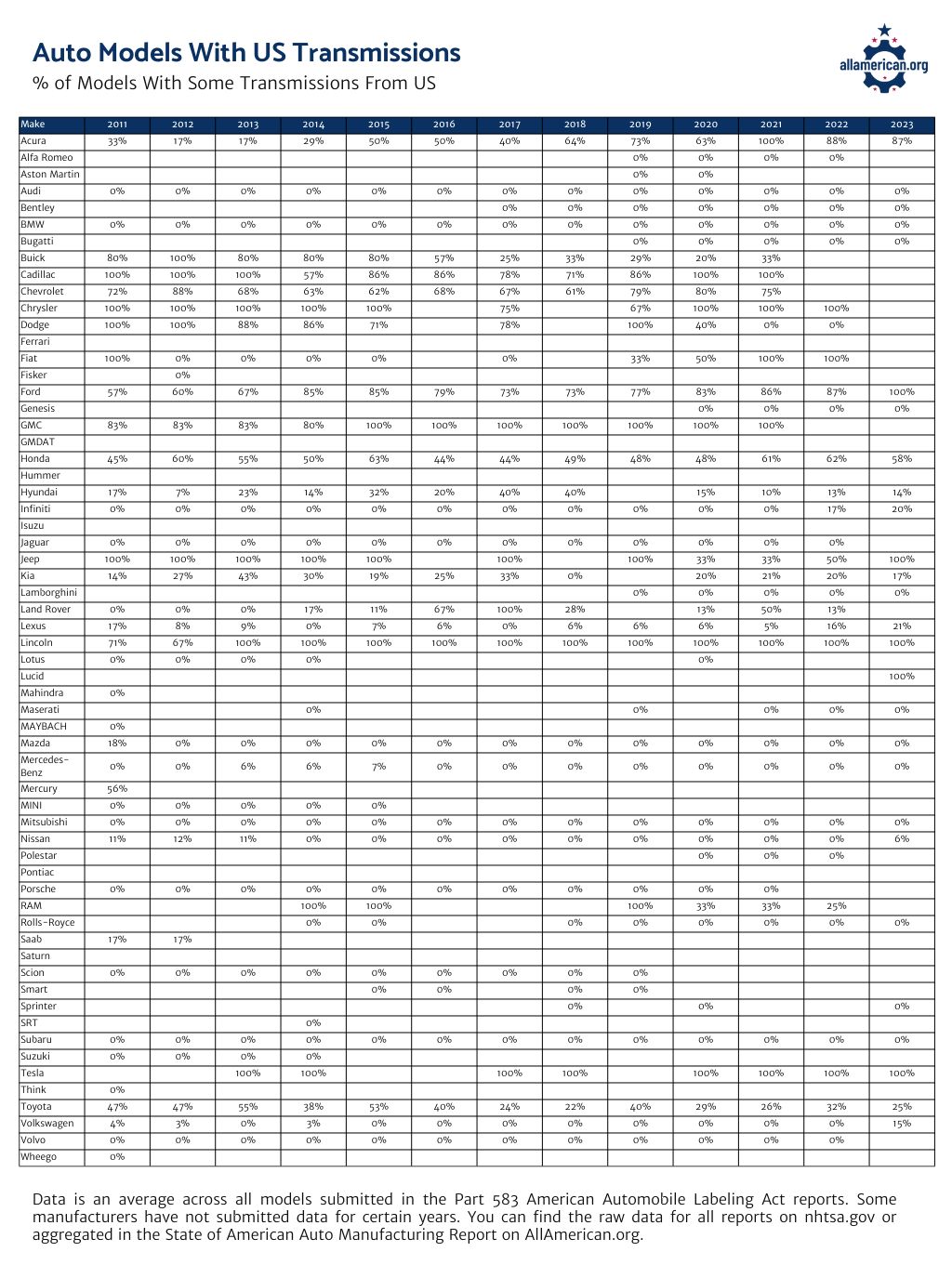
Citations:
- https://www.ibisworld.com/industry-statistics/market-size/car-automobile-manufacturing-united-states/
- https://www.statista.com/statistics/198488/us-and-global-motor-vehicle-production-since-1999/

